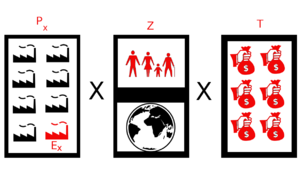
Anthropogenic global climate change has large and mounting negative economic impacts. Companies and nations responsible for greenhouse gas (GHG) emissions are thus acquiring considerable potential liabilities. If litigation becomes widespread, renewable energy technologies (RETs) potentially offer emitters reduced liability for climate change. This benefit has been ignored because of the lack of knowledge of potential liabilities. To overcome this information deficit, this paper reviews recent literature on the potential for climate change litigation and methods to quantify liability for climate change. Next, the top ten emitters in the U.S. are identified and their potential liability is quantified using standard GHG emission costs. Potential liabilities are explored in depth with a single case study company comparing the results of the fractional liability from only natural disasters within the U.S. for a single year to a sensitivity of the future costs of carbon emissions from other sources of emission-related liability. Then classes of potential climate change litigants are identified and their capacity to bring such lawsuits are evaluated. The results show that the net income available to shareholders of large companies could see a significant reduction from the emissions liability related to only natural disasters in the U.S. from a single coal-fired power plant. Finally, a rough estimate of the economic risk associated with future scenarios and existing organized international potential litigants is quantified. The results show that potential liability for climate change for the Alliance of Small Island States is over $570 trillion. It is concluded that as emitters begin to be held liable for damages resulting from GHG emissions resulting in climate change, a high value for liability mitigation would provide additional powerful incentives for deployment of renewable energy technologies.Negin Heidari & Joshua M. Pearce. A Review of Greenhouse Gas Emission Liabilities as the Value of Renewable Energy for Mitigating Lawsuits for Climate Change Related Damages. Renewable and Sustainable Energy Reviews 55C (2016) pp. 899-908. DOI: http://dx.doi.org/10.1016/j.rser.2015.11.025 open access
See also[edit | edit source]

keywords = carbon emissions, greenhouse gas emissions, global catastrophic risk, climate change, energy policy, human mortality, climate genocide
Follow up
http://blog.ucsusa.org/elliott-negin/will-new-scientific-breakthroughs-pave-the-way-for-more-climate-related-lawsuits Heede, R. (2014). Tracing anthropogenic carbon dioxide and methane emissions to fossil fuel and cement producers, 1854–2010. Climatic Change, 122(1-2), 229-241. https://link.springer.com/article/10.1007/s10584-013-0986-y
In the News[edit | edit source]
- Climate Change Liability: How Renewables Can Help Protect Energy Companies - MTU News
- Michigan researchers put price tag on climate liability for fossil-fuel plants - Midwest Energy News, Democratic Underground, Organic Consumers Association, Great Lakes Echo
- Study: Utilities could face billion-dollar liabilities for most polluting power plants - Utility Dive
- Renewables Could Help Protect Energy Companies From Climate Change Liability Lawsuits - Claims Journal
- How renewables can help protect energy companies from climate change lawsuits - Phys.org
- Study: Energy Companies Face Growing Risk in Climate-Related Litigation - Institute for Energy Economics and Financial Analysis
- Climate-Related Liability Could be a Big Problem for Energy Companies - AZO Cleantech
- Utilities Knew: Documenting Electric Utilities' Early Knowledge and Ongoing Deception on Climate Change From 1968-2017 - Enery and Policy














